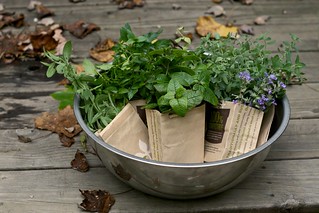| Spices (Photo credit: srqpix) |
With a little creativity, you can put a fresh spin on some of your favorite tried-and-true recipes by simply swapping out the herbs, spices and seasonings you use. For example, if you add fresh or dried basil or oregano to diced tomatoes, chopped onion and finely minced garlic, you have the makings of a wonderful red Italian pasta sauce. On the other hand, if you replace the basil and oregano with cilantro and lime juice, those same ingredients become the foundation for a fabulous homemade salsa recipe.
To help inspire you, the following chart shows some of the most popular culinary ingredients based on geographic region.
Most Popular Kitchen Seasonings From Around the World
Italian
basil, oregano, marjoram, rosemary, parsley
French
thyme, French tarragon, rosemary, basil, sage, mint, marjoram
Greek
dill, lemon, oregano, fennel
Spanish
saffron, smoked and regular paprika, rosemary, thyme
German
mustard, rye, caraway seeds, borage
Mexican
cilantro, chili powder, cumin, Mexican oregano
Indian
curry powder, coriander, cumin, turmeric
Chinese
five-spice powder, star anise, fennel seed, cloves, cinnamon, ginger
Thai
Thai basil, cumin, turmeric, lemon grass, cinnamon
Of course, this chart is far from comprehensive, but it can serve as a good reference point for assembling your own collection of must-have herbs, spices and seasonings.
| Harvesting Herbs (Photo credit: Chiot's Run) |
You will also see a lot of crossover among dishes from countries that border one another. For example, French, Italian, Greek and Spanish dishes often feature many of the same herbs, such as basil, rosemary, oregano and thyme. Of course, this isn’t surprising when you consider how these populations interacted with and melded together over the course of history. Depending on your personal tastes and cooking habits, these ingredients may be good to keep on hand, as well.
While assembling your own collection of herbs, spices and seasonings from around the world, remember you can save money by growing your own! Fresh herbs are super easy to grow from seed or from cuttings in your own garden and many can be brought indoors for year-round enjoyment.
However, if growing fresh herbs isn’t your thing, many popular fresh and dried varieties are readily available. Dried herbs can be a great alternative to fresh, but take note of expiration dates and suggested storage methods. Dried herbs, spices and seasonings can be quite expensive, so buy smaller amounts at one time if you won’t be using them often.


No comments:
Post a Comment
We welcome comments and suggestions!